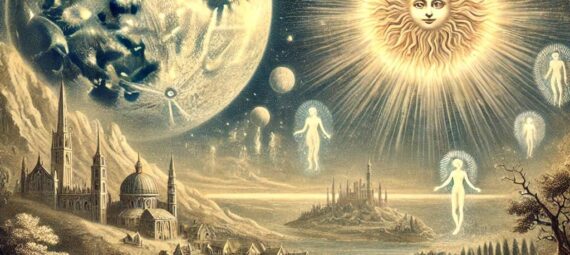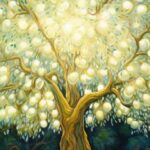The Journal of Discourses, a 19th-century collection of sermons from early leaders of The Church of Jesus Christ of Latter-day Saints (LDS Church), contains many fascinating statements that reflect both the theological and scientific perspectives of the time. Among these are claims that the Moon and even the Sun might be inhabited. Statements like these have been the subject of controversy, curiosity, and misinterpretation. Understanding the historical and theological context is essential to assessing their meaning.
The Origins of the Claim: Who Said What?
Brigham Young on the Inhabited Moon and Sun
Brigham Young, the second president of the LDS Church and a key figure in its early expansion, reportedly made remarks suggesting that celestial bodies, including the Moon and Sun, were inhabited. While no direct quote from him in the Journal of Discourses explicitly states this, various accounts suggest that such ideas were entertained by early Latter-day Saints.
For example, one statement often attributed to Young goes as follows:
“Who can tell us of the inhabitants of this little planet that shines in the night, called the Moon? When you inquire about the inhabitants of that sphere, you find that the most learned are as ignorant in regard to them as the ignorant of their fellow beings. So it is with regard to the inhabitants of the Sun. Do you think it is inhabited? I rather think it is. Do you think there is any life there? No question of it; it was not made in vain.”
(Brigham Young, Journal of Discourses, Vol. 13, p. 271, 1870)
From this passage, it is clear that Young was speculating on the potential for life in the cosmos rather than declaring a doctrinal position. His argument is rooted in the belief that God created celestial bodies for a purpose and that life might exist beyond Earth.
Joseph Smith and the “Moon Quakers” Story
A more detailed claim about lunar inhabitants is often attributed to Joseph Smith, the founder of the LDS Church. The source of this story comes from Oliver B. Huntington, who wrote in his journal that Joseph Smith had taught the Moon was inhabited by people who dressed like Quakers and lived for a thousand years. This account was later published in The Young Woman’s Journal in 1892, decades after Smith’s death:
“As far back as 1837, I know that he said the moon was inhabited by men and women the same as this earth, and that they lived to a greater age than we do—that they lived generally to near the age of a thousand years. He described their dress as being about the style of the Quaker costume.”
(Oliver B. Huntington, The Young Woman’s Journal, 1892)
However, no contemporary records from Joseph Smith’s own writings or direct sermons confirm this statement. It remains anecdotal and secondhand, making it difficult to verify as an actual teaching of Smith.
The 19th-Century Scientific and Religious Context
To understand why early LDS leaders and members entertained the idea of inhabited celestial bodies, we must look at the broader scientific and religious context of the 19th century.
1. Plurality of Worlds in Christian Thought
The idea that other planets and celestial bodies were inhabited was not unique to Mormonism. Many 19th-century Christians, influenced by scientific discoveries and theological speculation, believed that God’s creation was vast and filled with life. Some Protestant theologians posited that if God was just, He would not create an entire universe with only one inhabited world.
2. Scientific Beliefs About Life on the Moon and Other Planets
At the time, many respected scientists and thinkers speculated about life beyond Earth. Astronomer William Herschel, famous for discovering Uranus, suggested that the Moon and even the Sun might harbor life. The belief in a “plurality of worlds” was popular, and some even thought they saw signs of civilization on the Moon through early telescopes. It was not until the late 19th and early 20th centuries that more accurate astronomical observations debunked these ideas.
3. LDS Theology and the Plurality of Worlds
Latter-day Saint scripture supports the idea that God created many worlds. The Book of Moses in the Pearl of Great Price states:
“And worlds without number have I created; and I also created them for mine own purpose.”
(Moses 1:33, Pearl of Great Price)
This verse, along with others in LDS scripture, emphasizes that Earth is not the only world created by God, and many early members took this to mean that all planets—including the Moon and Sun—could be inhabited.
Fallibility of Prophets and Their Historical Context
While some statements from LDS leaders, including Brigham Young, suggest that celestial bodies might be inhabited, there is no evidence that this was ever an official doctrine of the LDS Church. Instead, such remarks reflect personal beliefs, speculation, and the scientific understanding of the time.
It is important to recognize that Brigham Young and Joseph Smith, while considered prophets, were also fallible men who were products of their era. Their views were shaped by the scientific and cultural understandings of the 19th century. Just as other religious and scientific leaders of their time speculated about life on other celestial bodies, LDS leaders engaged with these ideas in ways that reflected their environment. Latter-day Saints believe that prophets receive divine revelation, but this does not mean they are infallible or beyond cultural influences.
The Journal of Discourses itself is not considered an official doctrinal source by the LDS Church today. Rather, it is a collection of sermons that provide insight into the thoughts and beliefs of early church leaders, some of which were cultural or speculative rather than doctrinally binding.
Modern LDS Perspective on Extraterrestrial Life
Today, the LDS Church does not teach that the Moon or the Sun are inhabited. However, the idea that God created multiple worlds remains a part of LDS theology. The Church remains neutral on the question of extraterrestrial life, neither affirming nor denying its existence. Many Latter-day Saints see no conflict between their faith and the possibility of life elsewhere in the universe.
The early speculations about inhabited celestial bodies are now understood within their historical context rather than as definitive religious teachings. As scientific understanding progressed, so did the Church’s approach to such ideas.
Conclusion: Understanding the Past, Looking to the Future
The statements in the Journal of Discourses regarding inhabitants of the Moon and Sun reflect the beliefs and scientific ideas of the 19th century rather than core LDS doctrine. Brigham Young’s remarks on the subject seem to be speculative rather than doctrinal, and the “Moon Quakers” story attributed to Joseph Smith lacks direct verification.
The broader LDS belief in the “plurality of worlds” remains intact but is now understood in a more nuanced way. While 19th-century assumptions about life on the Moon and Sun have been debunked by modern astronomy, the idea that God’s creation is vast and possibly teeming with life continues to be an open question for many religious believers.
Ultimately, these early speculations provide a fascinating glimpse into how science, religion, and culture intertwined in the 19th century, shaping the perspectives of those who lived in that era. As humanity explores the cosmos, the fundamental question of life beyond Earth remains as intriguing as ever.
The Journal of Discourses, a 19th-century collection of sermons from early leaders of The Church of Jesus Christ of Latter-day Saints (LDS Church), contains many fascinating statements that reflect both the theological and scientific perspectives of the time. Among these are claims that the Moon and even the Sun might be inhabited. Statements like these have been the subject of controversy, curiosity, and misinterpretation. Understanding the historical and theological context is essential to assessing their meaning.
The Origins of the Claim: Who Said What?
Brigham Young on the Inhabited Moon and Sun
Brigham Young, the second president of the LDS Church and a key figure in its early expansion, reportedly made remarks suggesting that celestial bodies, including the Moon and Sun, were inhabited. While no direct quote from him in the Journal of Discourses explicitly states this, various accounts suggest that such ideas were entertained by early Latter-day Saints.
For example, one statement often attributed to Young goes as follows:
“Who can tell us of the inhabitants of this little planet that shines in the night, called the Moon? When you inquire about the inhabitants of that sphere, you find that the most learned are as ignorant in regard to them as the ignorant of their fellow beings. So it is with regard to the inhabitants of the Sun. Do you think it is inhabited? I rather think it is. Do you think there is any life there? No question of it; it was not made in vain.”
(Brigham Young, Journal of Discourses, Vol. 13, p. 271, 1870)
From this passage, it is clear that Young was speculating on the potential for life in the cosmos rather than declaring a doctrinal position. His argument is rooted in the belief that God created celestial bodies for a purpose and that life might exist beyond Earth.
Joseph Smith and the “Moon Quakers” Story
A more detailed claim about lunar inhabitants is often attributed to Joseph Smith, the founder of the LDS Church. The source of this story comes from Oliver B. Huntington, who wrote in his journal that Joseph Smith had taught the Moon was inhabited by people who dressed like Quakers and lived for a thousand years. This account was later published in The Young Woman’s Journal in 1892, decades after Smith’s death:
“As far back as 1837, I know that he said the moon was inhabited by men and women the same as this earth, and that they lived to a greater age than we do—that they lived generally to near the age of a thousand years. He described their dress as being about the style of the Quaker costume.”
(Oliver B. Huntington, The Young Woman’s Journal, 1892)
However, no contemporary records from Joseph Smith’s own writings or direct sermons confirm this statement. It remains anecdotal and secondhand, making it difficult to verify as an actual teaching of Smith.
The 19th-Century Scientific and Religious Context
To understand why early LDS leaders and members entertained the idea of inhabited celestial bodies, we must look at the broader scientific and religious context of the 19th century.
1. Plurality of Worlds in Christian Thought
The idea that other planets and celestial bodies were inhabited was not unique to Mormonism. Many 19th-century Christians, influenced by scientific discoveries and theological speculation, believed that God’s creation was vast and filled with life. Some Protestant theologians posited that if God was just, He would not create an entire universe with only one inhabited world.
2. Scientific Beliefs About Life on the Moon and Other Planets
At the time, many respected scientists and thinkers speculated about life beyond Earth. Astronomer William Herschel, famous for discovering Uranus, suggested that the Moon and even the Sun might harbor life. The belief in a “plurality of worlds” was popular, and some even thought they saw signs of civilization on the Moon through early telescopes. It was not until the late 19th and early 20th centuries that more accurate astronomical observations debunked these ideas.
3. LDS Theology and the Plurality of Worlds
Latter-day Saint scripture supports the idea that God created many worlds. The Book of Moses in the Pearl of Great Price states:
“And worlds without number have I created; and I also created them for mine own purpose.”
(Moses 1:33, Pearl of Great Price)
This verse, along with others in LDS scripture, emphasizes that Earth is not the only world created by God, and many early members took this to mean that all planets—including the Moon and Sun—could be inhabited.
Fallibility of Prophets and Their Historical Context
While some statements from LDS leaders, including Brigham Young, suggest that celestial bodies might be inhabited, there is no evidence that this was ever an official doctrine of the LDS Church. Instead, such remarks reflect personal beliefs, speculation, and the scientific understanding of the time.
It is important to recognize that Brigham Young and Joseph Smith, while considered prophets, were also fallible men who were products of their era. Their views were shaped by the scientific and cultural understandings of the 19th century. Just as other religious and scientific leaders of their time speculated about life on other celestial bodies, LDS leaders engaged with these ideas in ways that reflected their environment. Latter-day Saints believe that prophets receive divine revelation, but this does not mean they are infallible or beyond cultural influences.
The Journal of Discourses itself is not considered an official doctrinal source by the LDS Church today. Rather, it is a collection of sermons that provide insight into the thoughts and beliefs of early church leaders, some of which were cultural or speculative rather than doctrinally binding.
Modern LDS Perspective on Extraterrestrial Life
Today, the LDS Church does not teach that the Moon or the Sun are inhabited. However, the idea that God created multiple worlds remains a part of LDS theology. The Church remains neutral on the question of extraterrestrial life, neither affirming nor denying its existence. Many Latter-day Saints see no conflict between their faith and the possibility of life elsewhere in the universe.
The early speculations about inhabited celestial bodies are now understood within their historical context rather than as definitive religious teachings. As scientific understanding progressed, so did the Church’s approach to such ideas.
Understanding the Past, Looking to the Future
The statements in the Journal of Discourses regarding inhabitants of the Moon and Sun reflect the beliefs and scientific ideas of the 19th century rather than core LDS doctrine. Brigham Young’s remarks on the subject seem to be speculative rather than doctrinal, and the “Moon Quakers” story attributed to Joseph Smith lacks direct verification.
The broader LDS belief in the “plurality of worlds” remains intact but is now understood in a more nuanced way. While 19th-century assumptions about life on the Moon and Sun have been debunked by modern astronomy, the idea that God’s creation is vast and possibly teeming with life continues to be an open question for many religious believers.
Ultimately, these early speculations provide a fascinating glimpse into how science, religion, and culture intertwined in the 19th century, shaping the perspectives of those who lived in that era. As humanity explores the cosmos, the fundamental question of life beyond Earth remains as intriguing as ever.





